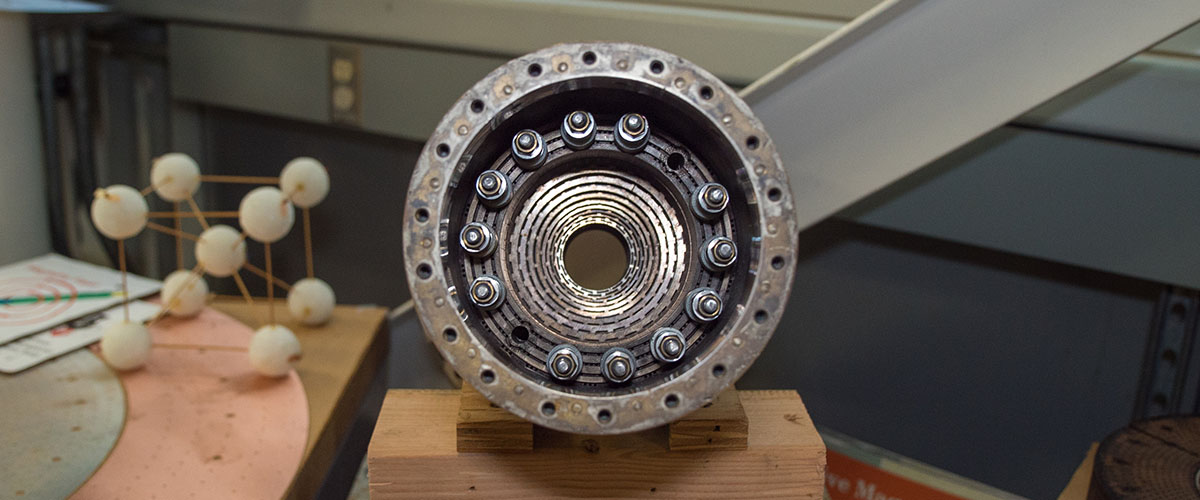
Dive deeper into these definitions of lab-wide lexicon as explained by MagLab experts.
What is basic research explained by MagLab Director, Greg Boebinger (spoiler: it's not like what most people mean when they call something basic).
What is a Bitter plate, and what does it have to do with powerful magnets? Learn from MagLab engineer Mark Bird.
What is the bore of a magnet? We promise, it's anything but boring. Get to the center of the term with MagLab engineer Jack Toth.
You've heard of physics, but what's condensed matter physics and why might it matter to you? DC Field Facility Director Tim Murphy explains.
What is cryogenics? Read an ultra-cool explanation from cryogenics operator Mark Vanderlaan.
You've heard of crystals, but what are they and what role do they play in a science lab? Read an answer as explained by MagLab user Chris Wiebe.
You know electrons, but what is electron magnetic resonance? As explained by EMR Facility Director Steve Hill.
Read how are scientists using magnets in cutting-edge experiments with this explanation by MagLab Director Greg Boebinger.
Find out what Fourier-transform ion cyclotron resonance is as explained by MagLab ICR Facility researcher Ryan Rodgers.
Your milk may be homogenized, but what is homogeneity in a magnet? Read an explanation from NMR Facility Faculty Bill Brey.
There are hybrid vehicles, fruits, and animals. But what is a hybrid magnet? Associate Lab Director Scott Hannahs explains.
You know Celsius and Fahrenheit, but what is a Kelvin? Read about this science scale as defined by DC Field Director Tim Murphy.
What's invisible, yet powerful? Magnetic fields! But what exactly are they? Learn from MagLab Director Greg Boebinger.
You've seen them in your doctor's office and on TV, but now read what magnetic resonance imaging is from MagLab researcher Sam Grant.
What's a mass spectrometer? This definition comes from geochemistry researcher Munir Humayun.
How much power is a megawatt? And how many megawatts power the massive magnets at the MagLab? Find out from head of magnet operations Bryan Dalton.
Nuclear Magnetic Resonance may sound scary, but this definition from NMR professor Tim Cross explains its role in finding molecular structures.
They're stuck to your fridge and filing cabinet, but what is a permanent magnet? MagLab researcher Scott Hannahs explains.
What is a probe and how are they used at the world's largest and highest-powered magnet lab? Learn from MagLab Director Greg Boebinger.
There are many different types of magnets. What is a pulsed magnet? A pulsed magnet is designed to produce magnetic fields that are so large that the …
The word "quench" may make you think of drinking a cup of water on a hot day. But learn what a magnet quench is from lab engineer Bob Walsh.
What makes a resistive magnet resistive as explained by MagLab engineer Mark Bird.
What is a superconducting magnet? A superconducting magnet is just like a regular electromagnet, except that there is no resistance to electricity and…
What exactly is superconductivity? And just how "super" is it? Learn more from Chief Materials Scientist David Larbalestier.
At the MagLab, we've got Tesla's in the parking lot and the magnets. Find out what tesla means at the MagLab from Deputy Lab Director Eric Palm.
What is a MagLab user and what exactly are they using? Get the explanation of this term from Deputy Lab Director Eric Palm.
A list of superconductivity definitions from critical magnetic field to reduced temperature created by Peter J. Lee.